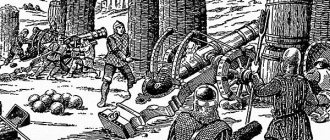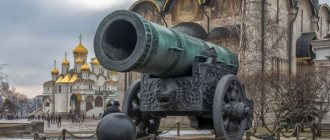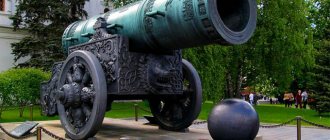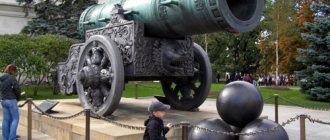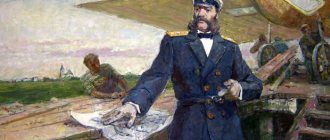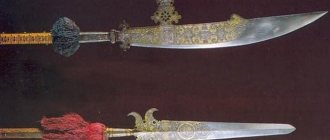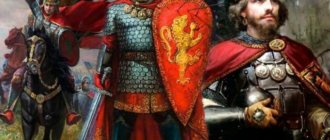A brief history of the Tsar Cannon in the Kremlin
The foundry monument was made by master Andrei Chokhov under Tsar Fyodor Ivanovich in the 80s of the 16th century. According to one version, the name “Tsar Cannon” is associated directly with the then ruler, and according to another, with the huge size of the object. But why was it necessary to create such a giant? According to historians, the cannon was destined to become a defensive weapon of the Moscow Kremlin - this conclusion was drawn from its original location on Red Square near Lobnoye Mesto. Some scholars suggest that the cannon could have been used to intimidate foreign ambassadors. In fact, the weapon was made after alarming news: the Crimean Tatars were marching on Moscow. Their army never reached the Kremlin walls, and the cannon remained a reminder of that time.
Later, the Tsar Cannon was moved several times: first under Peter the Great, then in 1835 and 1843, and finally twice during Soviet times in connection with construction. Due to the weight of almost 40 tons, this had to be done with great difficulty with the help of two hundred horses and special hooks on the hull for attaching ropes.
So where is the Tsar Cannon now? It is easy to find next to the Church of the Twelve Apostles and the Bell Tower of Ivan the Great on Ivanovskaya Square.
About the foundry master
Little information has been preserved about the gunsmith. He was probably born between 1540 and 1545. The first time his name was mentioned was in 1568. Then the future master cast his first cannon. It is believed that Chokhov is not a surname, but a patronymic. Czech or Chokh was probably his father's nickname. Andrei Chokhov studied foundry from the most famous master, Kashpir Ganusov.
Among his students, he stood out for his zeal and talent, for which he earned the special attention of his teacher. As his skill developed, Chokhov himself began to recruit students, who later also became famous as foundry masters. Among them are Pron Fedorov, Kondraty Mikhailov, Grigory Naumov, Alexey Nikiforov and others.
Description of the formidable weapon
Anyone who decides to be curious will be amazed by the size of the object: the barrel with a caliber of 890 mm reaches a length of more than 5 m, and its outer diameter is no less than 120 cm.
The Tsar Cannon is cast primarily from bronze, but the alloy also contains tin, lead, antimony, arsenic, iron, silver and other metals. Its trunk is decorated with bas-reliefs depicting Fyodor Ivanovich and ornaments. The carriage and decorative cannonballs, manufactured much later than the cannon itself, are made of cast iron alloy. Kernels arranged in a pyramid and hollow inside are not intended for use. If we imagine that they were real, then the barrel of the Tsar Cannon would simply be torn apart when trying to fire.
Although the giant looks impressive, research conducted casts doubt on its real combat power. The fact is that with such parameters the gun cannot be classified into any of the categories of artillery that exist today. The theory that the Tsar Cannon was designed as a shotgun and fired grapeshot does not stand up to criticism: its internal structure would have allowed the use of only stone shells. The only thing that researchers agree on is the possibility of classifying the gun as a bombard, and not as a cannon.
Predecessors
The Tsar Bell that we see today is not the first, and not even the second. The history of loud giants began with Tsar Ivan III. At that time, the rulers of Russia secretly competed with each other to see who would make the largest bell, surpassing all previous ones in weight, size and sound power. Under Ivan III, a bell weighing 8 tons was cast. Under his son, Vasily III, a 16-ton bell was made. And Ivan the Terrible ordered the casting of a bell weighing 35 tons. The record of those times was set by Alexey Mikhailovich - on his order, a 130-ton bell was built.
Tsar Lantern
Suzdal Cathedral. Illustration from the “Album of photographic views of monuments of ancient Russian art.” 1874. Photograph: Mikhail Nastyukov / State Hermitage Museum, St. Petersburg
Tsar Lantern. Vladimir-Suzdal Museum-Reserve, Suzdal, Vladimir region. Photo: Alexey Makarov / photobank “Lori”
Tsar Lantern. Vladimir-Suzdal Museum-Reserve, Suzdal, Vladimir Region, 1968. Photo: Viktor Velikzhanin, Petr Nosov / TASS photo chronicle
The two-meter lamp, made in the 17th century by Kholmogory craftsmen, was popularly nicknamed the Tsar Lantern. The 160-kilogram lantern was carried out during solemn religious processions, which were established under Metropolitan Hilarion of Suzdal and Yuryev.
It was made of gilded copper, cast iron and mica, and the top was made in the shape of the Nativity Cathedral with five domes. Candles were placed inside through a special window, which, thanks to their special structure, did not go out even in strong winds. On church holidays, such as Epiphany or before Easter, the grand lantern was carried out by eight people, threading shafts through special “ears.”
In the 1970s, the dilapidated structure was updated: the famous reconstructor Vyacheslav Basov specially traveled to Karelia for rare mica and restored the intricate patterns from the surviving drawings. Today the Tsar Lantern can be seen in the Kremlin museum complex of the Vladimir-Suzdal Museum-Reserve.
Tsar Coin
Sestroretsk copper ruble. 1771. Kaliningrad Regional History and Art Museum, Kaliningrad
Coin. The so-called Sestroretsk ruble, minted on a thick circle. Ruble. 1771. State Hermitage Museum, St. Petersburg
Sestroretsk arms factory. Before 1900. St. Petersburg. Photo: commons.wikimedia.org
The Sestroretsk ruble, issued by Catherine II, is called the Tsar Coin. This is the largest round coin of the Russian Empire, weighing almost a kilogram, with a diameter of 7.25 centimeters and a thickness of 2.6 centimeters.
In February 1770, a personal decree of Empress Catherine II “On the Making of a New Copper Coin” was issued. The new ruble was supposed to provide banknotes - the first paper money in the country, which appeared a year earlier. They decided to mint the giant coins at the Sestroretsk Arms Factory. At the beginning of 1771, the first samples were made on special machines. The originals are now kept in the Hermitage and the Smithsonian Institution Museum in the USA.
On the obverse of the Tsar Coin there was the inscription “Ruble Coin” and a crown framed by a laurel wreath. On the reverse is a double-headed eagle with a cartouche “1771” on the chest instead of a coat of arms, bordered by laurel leaves. On the edge (edge of the coin) the words “Sestroretsk Mint” were inscribed in an elegant pattern.
The Sestroretsk ruble was minted from 1771 to 1778, not only of the exemplary type, but also of a different thickness, weight and decoration. At least four types of coins appeared - from one and a half to three and a half centimeters thick, as well as a large number of remakes and fakes. Collectors are still hunting for them.
Tsar bath
Babolovsky Palace. 1901–1910. Saint Petersburg. Illustration from the book “Architectural Monuments of the Suburbs of Leningrad.” Leningrad: Stroyizdat, 1985
Babolovsky Palace. Late 19th century (?). Tsarskoe Selo, St. Petersburg. Photo: State Art and Architectural Palace and Park Museum-Reserve “Tsarskoe Selo”, St. Petersburg
Babolovsky Palace. Beginning of the 20th century. Tsarskoe Selo, St. Petersburg. Photo: State Art and Architectural Palace and Park Museum-Reserve “Tsarskoe Selo”, St. Petersburg
The legendary bath is also called the “Babolovskaya Cup”: its origin is connected with the history of the Babolovsky Palace in Tsarskoye Selo. In 1785, it was built according to the design of the architect Ilya Neelov for the favorite of Catherine II, Prince Grigory Potemkin. In a neo-Gothic pavilion across the Kuzminka River near the Silver Pond, a bathhouse with a marble bath was installed.
Under Alexander I, they decided to replace the old bathtub. In 1811, the imperial attorney Augustin Betancourt ordered it to the famous stonemason Samson Sukhanov, one of the creators of the Rostral columns on the Spit of Vasilievsky Island. A red granite block interspersed with semi-precious Labradorite stone was brought by water from the Finnish islands. She weighed 163 tons. The sculptor was helped by apprentices; over seven years they carved a 48-ton bowl from the monolith, 1.96 meters high and 1.52 meters deep.
Finally, this year Sukhanov finished the wonderful, only bath for the Babel bathhouse. Many of the St. Petersburg residents went specifically to see this work of the Russian Sculptor. It deserves attention because nothing so huge made of granite has been known since the time of the Egyptians.
“Domestic Notes of Pavel Svinin”, 1818
To accommodate the grand bath with a diameter of 5.33 meters and an approximate volume of 23 thousand cubic meters, reconstruction of the palace was required. In 1824–1829, according to the design of Vasily Stasov, a fortified pavilion with a brick vault and a circular cast-iron gallery was erected for the bathing hall.
After the revolution of 1917, a pilot training school was located in the Babolovsky Palace and Park. As a military facility during the Great Patriotic War, the complex was bombed more than once. The Germans wanted to take away the rare exhibit, but it turned out to be too heavy. In 1944, after a fire, only the octagonal hall with Sukhanov’s Tsar Bath survived.
Characteristics and design
The Tsar Cannon parts have the following dimensions:
- outer diameter of the barrel - 1200 mm;
- internal 825 - 920 mm (the barrel is cone-shaped);
- patterned belt 1340 mm;
- charging chamber diameter 447 - 467 mm (cone shape);
- charging chamber size 440×1740 mm;
- length 534 cm;
- the mass of the entire structure is 39312 kg.
The reliefs on the front of the barrel depict Tsar Fyodor Ivanovich on horseback with inscriptions dedicated to the Tsar and Grand Duchess Irina. On the other side there is an inscription carved telling who made the weapon.
Features of visiting and cost
In order to see the attraction, you need to purchase a ticket to visit the territory of the Moscow Kremlin. It can be purchased at the box office of the Kremlin museums located in the Alexander Garden, in the terminal of the cash pavilion, and on the official website of the Kremlin museums.
The cost of tickets allowing you to get acquainted with the architectural ensemble of the Kremlin’s Cathedral Square:
- full — 700 rub.
- preferential (for full-time students and pensioners) - 500 rubles.
For an additional fee of 300 rubles. You can rent an audio guide.
Children under 16 years old visit the territory for free.
Before visiting, we recommend that you check the current prices on the official website of the Moscow Kremlin museums.
Operating hours of the architectural ensemble:
- from May 15 to September 30 from 9:00 to 17:00
- from October 1 to May 14 from 9:30 to 16:30.
Images and inscriptions on the bell, © Maria Penina
History of creation
In 1730, Empress Anna Ioannovna, for the memory of posterity, decided to refill the bell of Tsar Alexei, which at that time had broken, was refilled and broken again.
Russian master Ivan Motorin took up the work. First, he made a small test model, weighing 12 pounds, and sent all his drawings and lifting diagram to St. Petersburg for approval. It took more than a year and a half to prepare for the production of the Tsar Bell. The bell itself was cast on November 25, 1735. The dimensions of the Tsar Bell were truly enormous. Master Ivan Motorin did not live to see the work completed, so his son Mikhail continued his work. In total, about 200 people worked on the creation of the Tsar Bell: blacksmiths, mechanics, carpenters, sculptors, carvers and many others.
Then they could not lift the bell - it remained in the foundry pit. It was pulled out and placed on a pedestal only in 1834.
Tsar-book
Jason's extraction of the golden fleece. The Dragon. Facial chronicle vault. The World History. Book 1. 1568–1576. State Historical Museum, Moscow
Indian campaign of Alexander the Great. Elephants. Facial chronicle vault. The World History. Book 3. 1568–1576. Russian National Library, St. Petersburg
The expulsion of Adam and Eve from the Garden of Eden by the Lord God. Facial chronicle vault. Biblical history. Book 1. 1568–1576. State Historical Museum, Moscow
The facial chronicle of Ivan the Terrible - a monumental 10-volume work - was produced in a single copy for the legendary library of the tsar. Researchers suggest that it was created in 1568–1576. This king-book is a real illustrated encyclopedia. On ten thousand sheets of rag paper, about 15 authors described events from the creation of the world to 1567, and 10 artists painted more than 17 thousand different miniatures. These are biblical stories, the Trojan War, the campaigns of Alexander the Great, the fall of Rome, the formation of Byzantium, Batu’s invasion of Rus' and others. The masters depicted medieval skis and ancient cannons, military armor, church vestments and feasts at royal weddings.
The largest chronicle collection of Ancient Rus' is kept today in three places. Three parts - the Museum Collection, the Synodal Volume and the Royal Book - are in the Historical Museum. Chronographic collection, Osterman's first and second volumes - in the Library of the Russian Academy of Sciences. And the Face Chronograph, Golitsynsky, Laptevsky and Shumilovsky volumes are in the Russian National Library.
